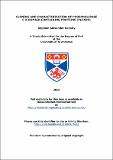Files in this item
Cloning and characterisation of phospholipase C X-domain containing proteins (PLCXDs)
Item metadata
| dc.contributor.advisor | Cramb, Gordon | |
| dc.contributor.author | Gellatly, Steven Alexander | |
| dc.coverage.spatial | 259 | en_US |
| dc.date.accessioned | 2015-07-27T11:53:01Z | |
| dc.date.available | 2015-07-27T11:53:01Z | |
| dc.date.issued | 2015 | |
| dc.identifier.uri | https://hdl.handle.net/10023/7033 | |
| dc.description.abstract | Members of the phosphoinositide-specific phospholipase C (PI-PLC) enzyme family play a fundamental role in cell signalling pathways by regulating cytosolic calcium and/or the activity of several protein kinases. This thesis reports the identification, molecular cloning and characterisation of a potential seventh sub-class of the PI-PLC enzyme family, the phospholipase C X-domain containing proteins (PLCXDs), which contain only an X domain in their structure. Comparative sequence analysis has identified at least three PLCXD isoforms in the human and mouse genomes (PLCXDs 1, 2 and 3), and at least four isoforms in the European eel (PLCXDs 1-4). Key amino acid residues responsible for the catalytic properties of PI-PLCs were found to be conserved in human, mouse and eel PLCXDs 1, 2 and 3, but were absent in the sequence of eel PLCXD4. PLCXD isoforms displayed unique tissue-specific expression profiles and some similarities between species. Interestingly, in mouse PLCXD1-3 mRNA were found to be predominantly expressed in the brain, however this is yet to be confirmed in humans. Analysis of in situ hybridisation data in mice revealed each PLCXD to be localised in neurons within different brain regions, highly suggestive of unique roles in brain function. Furthermore, the levels of PLCXD3 protein were reduced by more than 99% in cerebella samples from a mouse model of neurodegeneration (Harlequin mouse) compared to control mice. Human PLCXD1, 2 and 3 were found to increase phosphoinositide turnover when overexpressed in the HeLa cell line, and recombinant PLCXD3, purified to homogeneity from E. coli, was found to interact with various phosphoinositides including PI(4,5)P₂. ³¹P-NMR analysis of PI(4,5)P₂ and PI before and after the addition of PLCXD3 purified from HeLa cells and E. coli revealed no difference in the ³¹P spectra whereas expected chemical shifts were seen following the addition of purified bacterial PI-PLC. Significant formation of inclusion bodies was noted when human PLCXDs 1, 2 and 3 were expressed as recombinant proteins in E. coli. Different strategies aimed at optimising the expression of recombinant PLCXD1, 2 and 3, including the use of different fusion proteins and screening expression in E. coli, mammalian and insect cells had limited success, with the best soluble expression only seen with PLCXD3 in insect cells. Attempts to scale-up the purification of PLCXD3 from insect cells to provide sufficient protein for enzyme assays and crystal screens were unsuccessful. The results presented herein suggest that these novel proteins possess distinct and as yet uncharacterised tissue-specific roles in cell physiology. | en_US |
| dc.language.iso | en | en_US |
| dc.publisher | University of St Andrews | |
| dc.subject.lcc | QP609.P555G4 | |
| dc.subject.lcc | Phospholipase C | en_US |
| dc.title | Cloning and characterisation of phospholipase C X-domain containing proteins (PLCXDs) | en_US |
| dc.type | Thesis | en_US |
| dc.type.qualificationlevel | Doctoral | en_US |
| dc.type.qualificationname | PhD Doctor of Philosophy | en_US |
| dc.publisher.institution | The University of St Andrews | en_US |
This item appears in the following Collection(s)
Items in the St Andrews Research Repository are protected by copyright, with all rights reserved, unless otherwise indicated.

